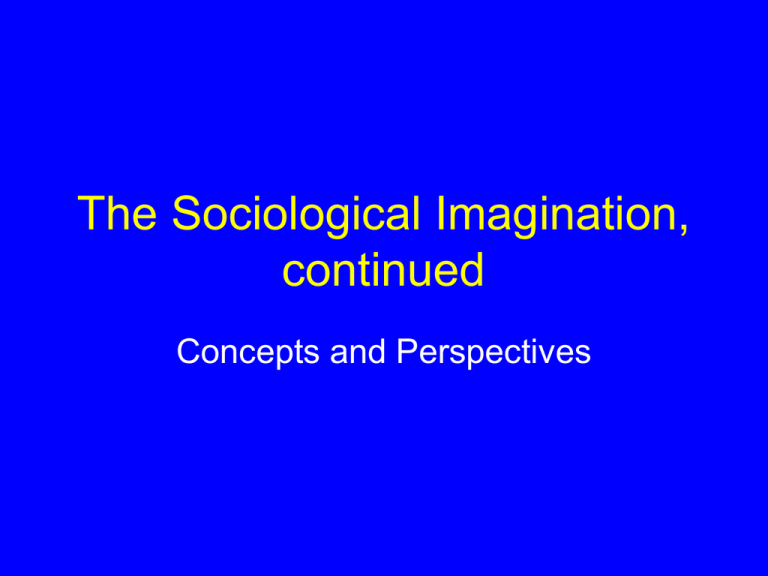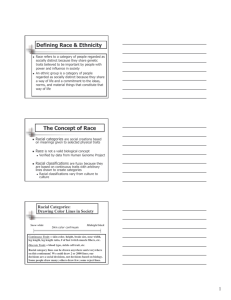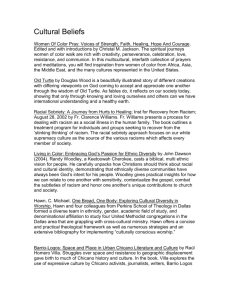The Sociological Imagination, continued
advertisement

The Sociological Imagination, continued Concepts and Perspectives What is race? • At one time, a group that had more physical and moral characteristics in common with one another than with other races. • Now, a socially constructed category of individuals seen by society as biologically and inherently distinct from other races. The Biology of Race • Harris: How did our skins get their color? • Graves (2002): as few as six genes out of the total of 30-40 thousand genes could account for skin color differences. • Brown and Armelagos (2001): no longer makes sense to adhere to arbitrary racial categories. But, outcomes are associated with race • A higher percentage of black infants than white infants die before reaching their first birthday. • The average number of years that an African American can expect to live is lower than that for a white American. • Race: A socially constructed category— real in its consequences. What is ethnicity? • A group characterized by cultural practices and beliefs that distinguish them from other groups in society? • Are they real? • Socially constructed from within and without: Latina and Puerto Rican (J-Lo) What is a minority group? • A group of people afforded less favorable treatment than others because of their membership in the group. • Not all minority groups are racial and ethnic groups. • Not all minority groups are numerically smaller than the majority group. Range of attitudes about racial and ethnic groups other than ones’ own • Relativism (extreme) – E.G.: female genital mutilation – Dietary prohibitions (pork, alcohol, caffeine) • Ethnocentrism • Racism (different from prejudice) • Where do you fit? Attitudes about incorporating racial and ethnic minorities • Xenophobia • Melting Pot • Multiculturalism (U.S. Constitution: no official language, no official religion, now no racial criteria for citizenship) White Privilege • What is it? • Advantages accruing to white people in American society by virtue of socially constructed identities? Examples? • Racial profiling, service in stores, real estate agents, landlords • Non-discriminators can benefit from white privilege Discrimination • What is it? • Denial of opportunities to members of a group because of their group membership. • Types (Jencks, 1992): – Principled (ethnic solidarity): Is it ok for black businessmen to favor black suppliers but not for white businessmen to favor white suppliers? Discrimination, continued • Myopic (rooted in stereotypes) • Statistical • Institutional The History of Sociological Perspectives • 18th Century: Ethnocentrism— recognition but disapproval of cultural differences • 19th-20th Centuries: Imperialism, Colonialism, Social Darwinism, Scientific Racism • 20th Century: Cultural Diversity, Cultural Pluralism, and Cultural Relativism Developing Our Sociological Imagination: Taking Stock 1. Social and political acceptance of African Americans is much greater than in the middle of the 20th Century. 2. Immigration has significantly changed the racial composition of many areas, especially large cities. Taking Stock, continued 3. The Civil Rights Movement and its aftermath led other racial and ethnic groups to focus on their own political and economic issues. 4. Gender relations have changed significantly during the past 50 years. (Women have more choices, but many barriers remain) 5. Globalization A Model for Understanding Contemporary Racial and Ethnic Relations • Important to recognize consensus and conflict • Ignoring conflict or glossing it over is dangerous: a false or imposed consensus • Conflict carried out in the political arena is good for our society A Model,continued • Americans can be Americans and also be, – African, Mexican, Chickasaw, Jewish, Arab – Maintain an interest and tie with their actual or emotional homeland (Africa, Israel, Palestine, Mexico) American Indians as a Model for How to be an American • The Pow Wow • A particularly Indian event • But, American flags, flag songs, veterans groups, veterans songs • Royalty modeled after beauty contests • The fact that American Indians are Indians and Americans simultaneously reflects the major themes of this course. Progress, Problems, and Possible Solutions: Progress • Discarding race as a biological concept and the explicit recognition that race and ethnicity are socially constructed categories • Using the scientific method to study race and ethnicity • Moving beyond an exclusive focus on blacks and whites. Current Problems • Preoccupation with the black/white divide • Insufficient attention to the impact of globalization • Insufficient attention to the roles of gender and class Potential Solutions • More research on Asians, Latinos, and smaller understudied groups • Explicit attention to the international context • Including gender and class in examining race and ethnic relations Historical Images • Noble Savage • Destructive Heathen • Broken, Destitute Indian • Gaming Enriched Indian Contemporary Uses of These Images • A Critique of American Society – Dances with Wolves – Thunderheart • An Affirmation of American Society – Weapons – Mascots – Advertising Why are these images so popular? • • • • • Extent of Popularity Part of common American images Fascinating Safe Resistance to Change: Symbolic Politics Are these images harmful? • Do they perpetuate stereotypes? • Do they impede understanding? • Good clean fun v. respectable bigotry? What Should be Done? • Arguments Against the Continued Use of American Indian Images – stereotypes, demeaning • Arguments in Favor of the Continued Use of American Indian Images – free speech, honor Indians, Indians do it • Important to Move Beyond These Images









